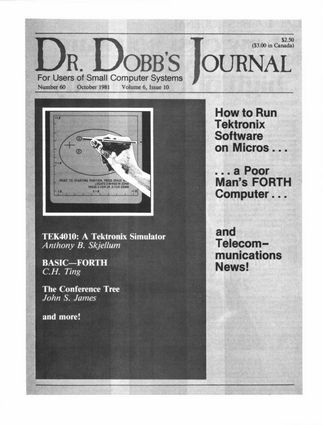
[author : Marlin Ouverson] #Edito
Extract : « We are pleased to present BASIC-FORTH in this month’s menu of articles. For those who were fascinated by September’s all-FORTH issue, but do not yet have the language, this is, in the author’s words, "a poor man’s FORTH machine." We were tempted to call it hors d’forth because it is just enough to whet the appetite and raise some interesting possibilities. [...] »
TABLE OF CONTENTS
#Experience #Encoding #Listing #Assembly
Extract : « Binary to Decimal [...]
Shifts and Adds [...]
Faster, Smaller Division [...]
Even Faster, But Only Smaller [...]
Bulky Conversion to Decimal (BCD) [...]
Decimals, Always Adding (DAA) [...]
Decimal, Subtracting Binary Conversion (DSBC) [...] »
[author : Anthony Skjellum] #Listing #Assembly #Simulation
Extract : « [...] This article presents a program which simulates a Tektronix 4010 graphics terminal on a Z80 microcomputer system. This simulator was written to allow applications programs written on a VAX-11/780 (for use with a standard 4010 terminal) to run unmodified with the Z80 computer system acting as the graphics terminal.
While software of this type is usually system dependent, this implementation is likely to be useful to others planning to write Tektronix simulators for their own hardware configuration. Even though the software depends on the setup of the development system, it could well be modified for other graphics environments. The code was designed for use in a read-only memory and is therefore ROMable.[...] »
[author : C. H. Ting] #Listing #BASIC #Forth #Programming
Extract : « My favorite definition of the FORTH language is "a programming language by which a programmer creates a set of instructions as the solution of his programming problem." The fact that FORTH allows and encourages the programmer to extend and modify its instruction set makes this language unique and exciting, and consequently attracts a host of religiously devoted followers. However, there are still two factors impeding FORTH’s even wider growth and dissemination; the peculiar syntax using postfix (reverse Polish) notation, and the expense of a computer which can host a FORTH operating system (above $2000). Such a computer must have at least one diskette drive for bootstrapping and program storage [...] »
[author : John S. James] #SocialNetworks
Extract : « [...] The Conference Tree program was originally designed for the personal use of the author, who was swamped by questions about FORTH. Most of the queries needed a search through books and papers, for information the requestor had no other practical way to get. It would be easier to give a phone number to a FORTH computer conference (e.g., 415-538-3580), with instructions to type two carriage returns, and suggest leaving a query on the computer if the information wasn’t there already.
The existing computerized bulletin boards would not have handled this job very well. They store messages linearly with all subjects together, not by related groups. It can be hard to find comments, answers or other references to a given message. Their numbering of messages and use of many single-letter commands make the systems harder to learn for those who have never used any computer.
The Conference Tree is a hierarchical (tree-structured) database of messages, designed to be accessed by telephone, with categories and sub-categories determined entirely by the users. After it was made available to the public as a test system (February 1981), many new uses were suggested, some not imagined by the designer. The same software could be an on-line newsletter, a technical meeting or journal with immediate feedback, a movie or restaurant guide, a tool for decentralized political action or for a private business team, or a way for retired executives to keep in touch. In short, it would be a general-purpose tool. The system was productized and documented, and released in July 1981. [...] »
[author : Dave Cortesi] #Book #ComputerDesktop
Extract : « New Hardware: Large, Small, Distributed (Ithaca Intersystems, MicroDaSys, Data General) [...]
Two Reports for Software Sellers (Superintendent of Documents, SOFTPROTEX) [...]
Hard and Soft Books [...]
Intuitive IC Electronics by T. M. Frederiksen (McGraw-Hill, $18.50). [...]
Real Time Programming by C. C. Foster (Addison- Wesley, $9.00). [...]
Two Compendia (Datapro Directory of Microcomputer Software, FYI Dr. Dobb’s diskette-based article index)
Math Libraries for All (math library that has been upgraded for the Cray-1, the Mathematical Programming System for Micros from MPI) [...]
General Software for CP/M (Digital Research, Knowlogy, Ficomp, Southern Computer Systems) [...]
5 Compilers, 4 Systems, 3 Languages (MicroAp, Ellis Computing, Phase One, TSC) [...]
Late News From IBM
On August 12th, IBM announced the IBM Personal Computer, a small home machine. [...] »